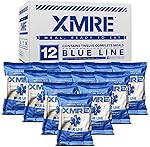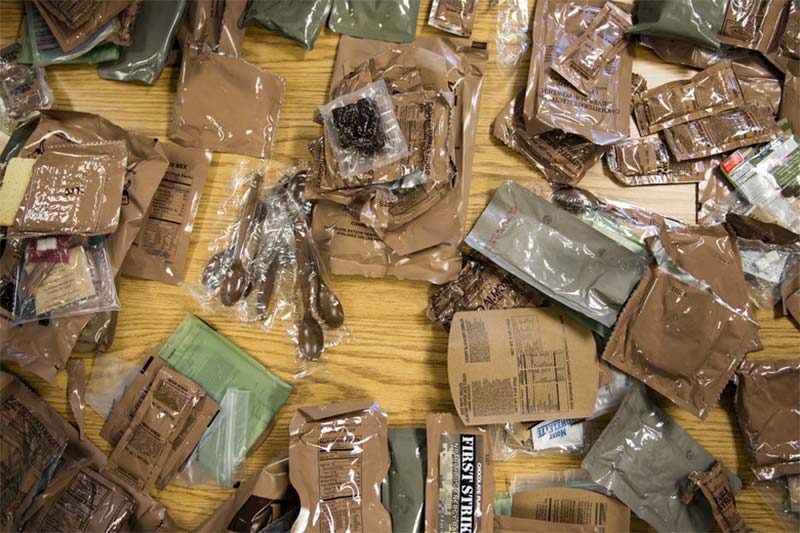Backpacking is one of those activities that is both peaceful and exhilarating.
Nothing can beat the serenity you feel as you traverse through untouched wilderness or the excitement that comes from tackling new and unique challenges.
And while backpacking is certainly ultra-enjoyable, so too is the experience of camping under the stars once you have reached your destination.
Camping is a great way to appreciate the bounty of nature, share stories around the campfire and, best of all, eat and refuel for the next day’s hike.
In this article we will focus on that last activity—eating and refueling—and introduce you to two of the best options available for dining out in the wilderness and enjoying what you eat.
Those two refueling options are the meals known simply throughout the backpacking community as MREs and Mountain House.
To help you become better informed about each brand, here we will provide an in-depth description of each of these meal types and explain how they stack up against each other with regard to several categories that are important to backpackers and campers.
| Our Mountain House Pick | Our MRE Pick |
 |
 |
| ☆ PERFECT FOR LIGHTER PACKS | ★ MORE CALORIES PER MEAL ★ |
| You only get an entree | Includes sides, dessert, and more |
| Buy at Amazon | Buy at Amazon |
MRE Explained
The pre-prepared meal option known as MRE is an acronym for “Meal Ready to Eat.”
For decades, this popular meal option has been used in the armed services and provided for soldiers on the battlefield who do not have any other option for securing food.
They have, for years, been consumed heartily by active-duty military personnel in hostile war zones like Korea, Vietnam, Iraq and Afghanistan, and, more recently, they have become a regular staple for campers and backpackers that wish to travel light as they explore some of the most well-known trails throughout the country.
It is the latter group—backpackers—that we will focus on in this article with respect to the two meal options.
All of the food you get in a typical MRE is pre-cooked and ready to eat, although most people prefer to heat certain items in the kit before consuming them.
As we will talk more about later, the average Meal Ready to Eat boasts about 1200 calories.
That makes them pretty substantial and ideal for those individuals who are burning a lot of daily calories as they hike.
The food is fairly nutritious, although it does contain plenty of preservative agents to extend its shelf life.
Many preppers and survival enthusiasts keep a stock of MREs on hand in preparation for some cataclysmic event (earthquake, hurricane, etc.) that might interrupt the normal food supply.
So what does a typical MRE contain? And what types of food can you expect when you open one of them?
Let’s take a look:

What Exactly Is In an MRE?
As you probably guessed from the average calorie count, MREs are pretty substantial and are able to provide enough energy and nutrients to sustain life, especially when they are consumed two to three times a day.
Unlike the other meal option we will discuss later, a typical MRE provides a variety of food types to ensure a (fairly) healthy balance of protein, carbohydrates and healthy fat.
When you open an MRE, here is what you can expect to find—although the food choices can vary slightly from this list.
- Entrée. Naturally, all MREs contain some type of entrée, almost all of which provide the needed protein to build and repair muscle. The entrées in MREs can range from beef stew to chicken to pork and even spaghetti with meatballs. There are also MREs that cater to the vegetarian, in which tofu, beans and other soy products are substituted for meat; and there are even breakfast MREs with eggs, sausage and more. According to the website com, consumers can now purchase a case of 12 MREs, in which they will receive a variety pack consisting of “5 different meat-based MREs, 3 different vegetarian-friendly MREs, and 4 breakfast MREs.”
- Sides. The side dishes you are likely to find in today’s MREs can vary greatly. Vegetables such as corn, potatoes, peas and green beans are common, while other MREs offer beans, rice or even fruit, which is common in the breakfast-based meals. In a case of 12 MREs you are apt to find about 7 or 8 different side dishes, giving you a lot of variety while you hike the trail.
- Snack/Spread. The snack you will find in an MRE is usually something very basic that has a lot of caloric density. For example, some MREs contain bread as the snack, while others may have a few crackers. The MRE will also contain a spread of some kind to further the number of calories that snack will provide—spreads such as peanut butter, jam or a simple cheese spread.
- Dessert + Candy. Unlike other pre-prepared meals, MREs almost always include some type of simple dessert as well as candy. Desserts and candy are included because they offer a lot of calories in a small package—caloric dense foods that don’t take up too much room. Certain types of cakes and cookies are often included as the dessert option, while the candy choices—usually chocolate—may include a fun-size candy bar, M&Ms or Tootsie Rolls.
- Drink Mixes. The drink mixes in MREs help to break the monotony of drinking water while adding a little more calories to the overall meal. Mixes for coffee and tea are pretty standard, as are juice and energy drink mixes.
- Seasoning/Condiment. Although not all MREs contain seasonings and/or condiments, some come with things like hot sauce, grated cheese, salt, pepper, or ketchup.
- Utensils and Accessories. One of the great things about MREs is that they come with the utensils you will need to eat them. This can include a fork and/or a spoon depending on the meal. Some MREs also include a variety of accessories, including a small pack of toilet paper, chewing gum, and creamer and sugar for your coffee.
The unique heater that is packed into all MREs give backpackers the luxury of easily warming up their meal prior to consuming it.
This can be a big plus when hiking or camping in wet environments, where starting a fire may be difficult to impossible. These heaters are also totally flameless.
Mountain House Explained
The description provided here for Mountain House meals will be a lot shorter, mainly because there is frankly less to tell.
Unlike MREs, which use preservatives to extend the shelf life of their foods, all Mountain House meals are freeze-dried, which allows them to keep longer than the former.
Mountain House meals do not consist of a lot of bells and whistles—no sides, snacks or candy. In fact, all you will get in a Mountain House meal is a tasty entrée.
Like the MREs, the entrees in the Mountain House meals can vary greatly, especially when you purchase them in bulk cases.
Beef, pork, chicken, fish—some of which are served over rice—as well as pasta meals are common.
Mountain House meals will provide you with less than half of the calories of MREs, in most cases around 500 calories per meal—enough to keep going but, for some people, not near enough to be completely sated.
Mountain House meals are completely dehydrated.
As such, if you bring along a collection of Mountain House meals on your next backpacking trip you will need to boil some of your clean water rations to heat up and rehydrate your food.
This requires you to build a fire in order to bring the water to a boil.
If you would rather not use your own clean water, you can always filter and boil some H2O from a nearby water source and use that instead to rehydrate your lunch or dinner.
Mountain House also makes meals for breakfast.
MREs vs. Mountain House: A Head to Head Comparison
Now that you understand the many differences and similarities between MRE and Mountain House meals, let’s see how they do in a head-to-head comparison with backpackers in mind.
Variety
When it comes to variety, MREs win hands down over Mountain House. With MREs, not only do you get a tasty entrée, you also get a side, snack, beverage and even utensils.
Mountain House meals only contain an entrée.
Many backpackers love that MREs come with so much variety, but others say they would rather bring their own (favorite) snacks and have no problem packing a lightweight utensil with which to eat their entrée.
Ease of Preparation
In terms of ease of preparation, this one is either a tie or leaning ever so slightly to the side of MREs.
MREs include a handy heater, but the heating process can often be pretty long and tedious.
Mountain House meals, on the other hand, are merely rehydrated with boiling water, which can be easy if the backpacker in question doesn’t mind using some of their fresh water.
However, when fresh water is not carried, and the backpacker must locate, filter and boil water before they can heat their dinner, that process can be a real pain in the neck.
Weight
The question of weight is why many backpackers today are turning away from MREs and turning toward options like Mountain House.
First, Mountain House meals only contain an entrée, which automatically makes them lighter in weight than the chock-filled MREs.
Also, because the food in the Mountain House meals is dehydrated, it does not have any water to weigh it down.
This is not the case with MREs.
MREs typically weigh about 16 ounces each, while Mountain House meals weigh just 6 ounces apiece.
And while you might think that a 10-ounce weight difference is not a big deal, think about those backpacking trips that might last weeks or even months, trips in which you would need to carry exponentially more meals.
This weight can quickly add up, weighing your pack down considerably and putting an extra “heft in your step.”
Assuming you eat three meals a day, a week’s worth of MREs would put 21 extra pounds into your pack, while the same number of Mountain House meals would add just under 8 pounds.
Of course, that weight would decrease with each passing day as you consume those meals, but the early cost in terms of the amount of energy you will have to expend will be great.
Calories
As we have mentioned earlier, MREs have more than double the calories of Mountain House dehydrated meals—1200 vs. 500.
MREs are also loaded with things like snacks, spreads, candy and beverages, some of which are very, very calorically dense.
This extra boost of calories can be a very big deal on extended hikes through the wilderness—activities that burn a lot of calories per hour.
The added calories also benefit larger hikers who have higher caloric demands.
People who opt to go with Mountain House meals will definitely need to bring along some calorie-dense snacks to keep them going; snacks ranging from peanut butter to chocolate to nuts.
Shelf Life
Finally, if you are a backpacker that enjoys taking long and extended treks—or just someone who likes to plan ahead—the shelf life of a given meal becomes very important.
This is another category in which Mountain House stands head and shoulders above its MRE counterpart.
Mountain House meals have a much longer shelf life than MREs because they do not contain water.
In the best climate controlled conditions, an MRE can last on the shelf anywhere between one and two years.
However, if you are hiking through very hot and humid climates—or storing the meals in the trunk of your car—that shelf life can begin to decrease dramatically, sometimes down to just 45-60 days.
On the flip side, Mountain House meals have a “posted” shelf life of 3-5 years depending on the type of meal.
In some cases, backpackers have consumed these meals some 8-10 years after they initially purchased them and reported no noticeable difference in the freshness or taste.
Simply put, foods that are dehydrated will last much longer on the shelf than those that are not, including MREs that contain a massive amount of preservatives.
Last Word
There are definitely pros and cons associated with both the MRE and Mountain House food options.
MREs unquestionably have more variation, more calories and, thanks to the included flameless ration heater, are a bit simpler to prepare.
Conversely, Mountain House meals have a much longer shelf life—making them a more treasured option for preppers—and, thanks to the fact that the entrée is fully dehydrated, are much less weighty, thus substantially lightening the load in your pack, particularly on longer treks.
| Our Mountain House Pick | Our MRE Pick |
 |
 |
| ☆ PERFECT FOR LIGHTER PACKS | ★ MORE CALORIES PER MEAL ★ |
| You only get an entree | Includes sides, dessert, and more |
| Buy at Amazon | Buy at Amazon |
top image: Moody AF Base
